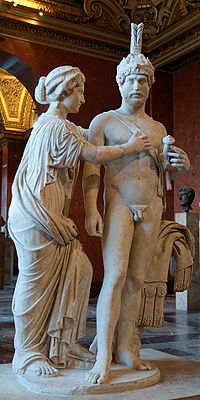
Venus and Mars (sculpture)
Encyclopedia

Mars (mythology)
Mars was the Roman god of war and also an agricultural guardian, a combination characteristic of early Rome. He was second in importance only to Jupiter, and he was the most prominent of the military gods worshipped by the Roman legions...
and Venus
Venus (mythology)
Venus is a Roman goddess principally associated with love, beauty, sex,sexual seduction and fertility, who played a key role in many Roman religious festivals and myths...
is a 1.73m tall marble statue of 120-140 AD (with restorations of c.170-175)
The male figure originally represented the emperor Hadrian
Hadrian
Hadrian , was Roman Emperor from 117 to 138. He is best known for building Hadrian's Wall, which marked the northern limit of Roman Britain. In Rome, he re-built the Pantheon and constructed the Temple of Venus and Roma. In addition to being emperor, Hadrian was a humanist and was philhellene in...
, but its head has later been restored to that of Lucius Verus
Lucius Verus
Lucius Verus , was Roman co-emperor with Marcus Aurelius, from 161 until his death.-Early life and career:Lucius Verus was the first born son to Avidia Plautia and Lucius Aelius Verus Caesar, the first adopted son and heir of Roman Emperor Hadrian . He was born and raised in Rome...
. Shown in the guise of Mars
Mars (mythology)
Mars was the Roman god of war and also an agricultural guardian, a combination characteristic of early Rome. He was second in importance only to Jupiter, and he was the most prominent of the military gods worshipped by the Roman legions...
, this makes Hadrian one of the first emperors to be portrayed as a god during his lifetime rather than be posthumously apotheosized
Apotheosis
Apotheosis is the glorification of a subject to divine level. The term has meanings in theology, where it refers to a belief, and in art, where it refers to a genre.In theology, the term apotheosis refers to the idea that an individual has been raised to godlike stature...
. The female figure, in the pose of the Capuan Venus
Capuan Venus
Venus of Capua is statuary type representing a semi-naked Aphrodite.Its prototype, named after its findspot at the ruins of an ancient theater in Capua, Italy, is now in the Museo Archeologico Nazionale Napoli...
, arms him. The present female head, changed in antiquity, does not belong to body and portrays Lucilla
Lucilla
Annia Aurelia Galeria Lucilla or Lucilla was the second daughter and third child of Roman Emperor Marcus Aurelius and Roman Empress Faustina the Younger and an elder sister to future Roman Emperor Commodus....
(Lucius Verus
Lucius Verus
Lucius Verus , was Roman co-emperor with Marcus Aurelius, from 161 until his death.-Early life and career:Lucius Verus was the first born son to Avidia Plautia and Lucius Aelius Verus Caesar, the first adopted son and heir of Roman Emperor Hadrian . He was born and raised in Rome...
's wife) - the original head was probably that of Vibia Sabina
Vibia Sabina
Vibia Sabina was a Roman Empress, wife and second cousin, once removed, to Roman Emperor Hadrian. She was the daughter to Salonina Matidia , and suffect consul Lucius Vibius Sabinus...
, Hadrian's wife.
The group reflects the hellenizing taste of the Hadrianic era and the revival of the neo classical or Neo-Attic
Neo-Attic
Neo-Attic or Atticizing is a sculptural style, beginning in Hellenistic sculpture and vase-painting of the 2nd century BCE and climaxing in Roman art of the 2nd century CE, copying, adapting or closely following the style shown in reliefs and statues of the Classical and Archaic periods...
style.

